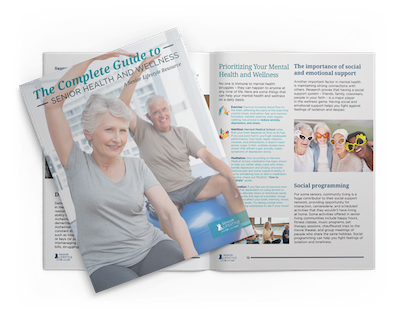There’s no sugar-coating these facts. According to the latest statistics from the American Diabetes Association, diabetes affects over 38 million Americans—that’s just over 11 percent of our population.
It has also been found that diabetes in seniors is even more prevalent. Americans aged 65 and over account for about 16.5 million of those with diabetes, meaning that about 1 in 4 seniors is currently living with the disease.

Download The Complete Guide to Senior Health and Wellness
As people grow older, their health and wellness needs change. Read our eBook, "The Complete Guide to Health & Wellness for Seniors" for everything you need to know about staying healthy and happy as we age.
Download the GuideThankfully, knowing the risk factors can help you avoid having to face this health issue as a senior. Join us as we take a deeper dive into the potential risks, share prevention tips, and discover how to live well even if you do develop diabetes as a senior.
Types of Diabetes
Type 2 diabetes is the most frequently seen form among seniors, often following a stage of prediabetes. Although type 1 diabetes is less common, it can develop at any age.
Let’s take a closer look at these conditions and what they mean for your health.
Prediabetes
Prediabetes is a condition where blood sugar levels are elevated beyond the normal range but have not yet reached the threshold for type 2 diabetes. With mindful lifestyle changes and healthy habits, many people can prevent progression.
Since prediabetes typically presents without noticeable symptoms, regular blood sugar screenings are key for early detection.
Type 1 Diabetes
Type 1 diabetes, once referred to as juvenile diabetes, is usually diagnosed in children and young adults, though it can occur at any age. It develops when the pancreas produces little or no insulin, the hormone that helps convert sugar into energy.
Some common signs include increased hunger and thirst, frequent urination, blurry vision, and unintentional weight loss.
Type 2 Diabetes
Type 2 diabetes is the most common form of diabetes, particularly among seniors and other age groups. It occurs when the pancreas does not produce enough insulin or when the body’s cells do not respond effectively to insulin, resulting in higher blood sugar levels.
Symptoms for type 2 diabetes include increased hunger and thirst, fatigue, slow-healing sores, frequent infections, numbness or tingling in the hands or feet, and areas of darkened skin—usually on the neck or in the armpits.
Risk Factors for Diabetes in Seniors
Type 1 diabetes is primarily influenced by family history, genetics, and geography. It is most often diagnosed in children between 4–7 and 10–14 years of age, making it less common among seniors.
However, factors such as lifestyle, weight, and physical inactivity can increase the risk of developing prediabetes as well as type 2 diabetes in seniors.
Weight
A main risk is being overweight or obese.
Inactivity
The less active a person is, the higher their risk of diabetes.
Fat distribution
Men with a waist circumference over 40 inches and women with a waist circumference over 35 inches are at greater risk.
Blood lipid levels
Low levels of high-density lipoprotein (HDL) cholesterol—the “good” cholesterol—and high levels of triglycerides can increase the risk of prediabetes and type 2.
Pregnancy-related risks
People who had gestational diabetes when they were pregnant or who gave birth to a baby weighing over 9 pounds are at higher risk.
Polycystic ovary syndrome
Women who have polycystic ovary syndrome have an increased risk of diabetes.
Age
As you get older, especially after 35, your risk for diabetes increases.
How Seniors Can Reduce Their Risk
The first step to reducing your risk for diabetes is to stay on top of your regular health checkups and tests. This can help both you and your physician notice early on if you have any risk factors that would require a lifestyle change. Your physician can also do a quick blood sugar test to catch any movement toward prediabetes or type 2 diabetes.
Other than regular checkups, a healthy lifestyle is always the best line of defense against diabetes. Get started by eating healthy foods that are low in fat and calories but high in fiber. Adding more fruits, vegetables, and whole grains to your diet is a great place to begin. Just make sure the fats you eat are “good fats.” That includes olive or canola oils, nuts and seeds, and fatty fish like salmon, sardines, or tuna.
Next, get up and get active! Talk to your doctor about your ideal activity level. It should include a mix of aerobics, such as walking, swimming, and biking, as well as resistance exercises like yoga or weightlifting.
If you’re eating healthy and staying active, it can help keep your weight in check, which is important for managing diabetes risk. However, if you do develop prediabetes, the American Diabetes Association notes that losing just 10-15 pounds can make a significant difference in delaying the progression to type 2 diabetes.
Living Well with Diabetes as a Senior
If you’re managing type 2 diabetes, many people are able to maintain balanced blood sugar levels through a nutritious diet and regular exercise. Make healthy choices for your meals and snacks, and set daily exercise goals. It’s also crucial to work with your healthcare team to create a personalized diet and exercise plan that supports your blood sugar control.
Your trusted healthcare team will also set up a plan for how often you should check your glucose levels and get the A1C hemoglobin test. This may include the prescription of medications to help manage the disease. Consistent monitoring and timely adjustments play a crucial role in reducing the risk of potential complications.
Managing diabetes means staying proactive. To stay as healthy as possible, do your best to keep up with preventative care such as testing and managing your blood pressure and cholesterol; getting annual eye exams and biannual dental check ups; keeping up with your cancer screenings; and getting your flu and pneumonia vaccines. Since diabetes affects the kidneys, you’ll also want to have them checked each year by your doctor.
Diabetes can sometimes affect the nerves and blood vessels in your feet, so it’s a good idea to check them regularly for any unusual changes, like red patches. If you notice anything like that, or if you have sores, blisters, or infections, it’s important to reach out to a podiatrist for advice and care.
Managing diabetes can feel overwhelming at times, and it’s completely normal to experience stress or frustration. The good news is, there are many support groups and organizations across the country that can offer help. If you’re feeling overwhelmed or simply want some support as you adjust to living with diabetes, consider visiting sites like the American Diabetes Association to find valuable resources and connections.
Above all, if you have any concerns about your diabetes management or treatment plan, talk with your healthcare provider. They are best suited to help you be prepared as well as guide you through living with this disease.
Make Connections That Matter with Senior Lifestyle
When it comes to preventing type 2 diabetes, you play the most important role. From healthy eating to staying active, there are choices you can make to help prevent diabetes before it even starts.
At Senior Lifestyle, we’re here to make it all a little easier. From expertly-planned restaurant-style dining and fitness options to personalized care, we help make seniors’ daily lives more elevated while ensuring their individual tastes and desired are met. This allows you to focus on what matters most: living your life, your style.
Whether you’re looking for Independent Living, Assisted Living, or personalized Memory Care in our Embrace Neighborhoods, you’ll find a place where comfort, care, and connection come together.
Find out more about Senior Lifestyle or schedule a visit today!

